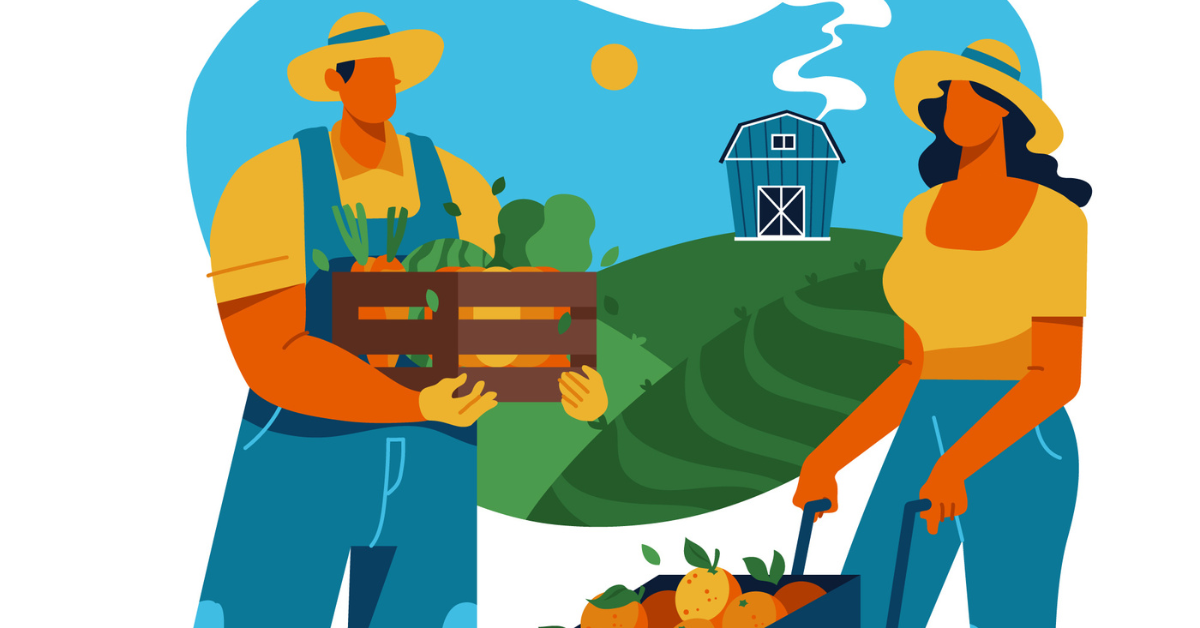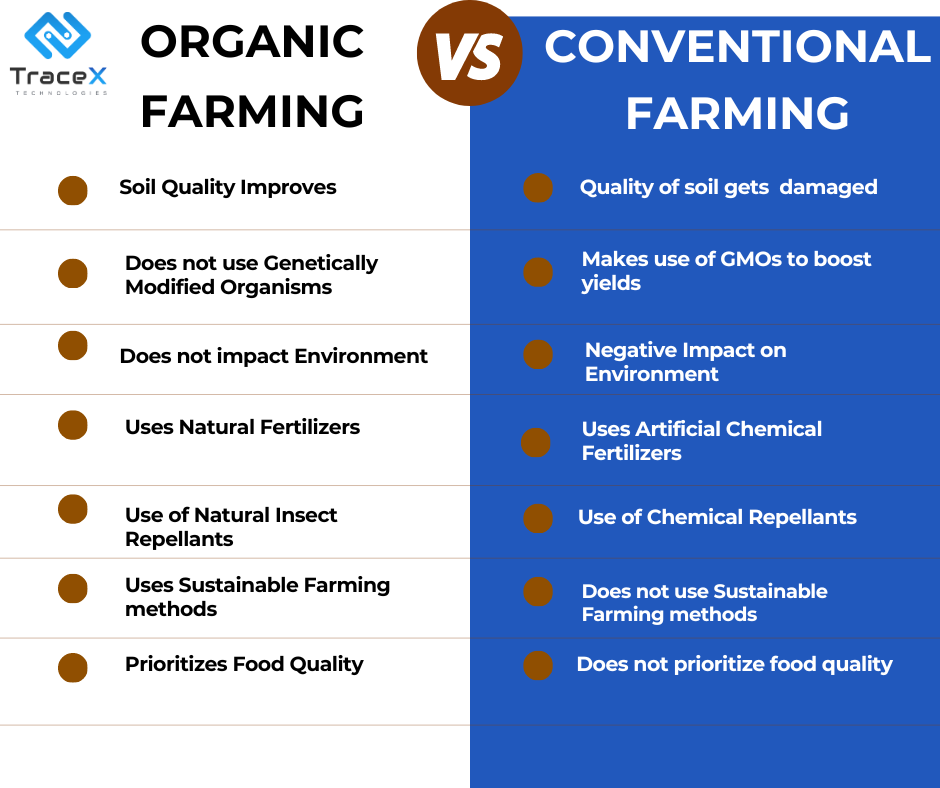Contact: +91 99725 24322 |
Menu
Menu
Quick summary: Explore the differences between organic and conventional farming in sustainable food supply chains and discover how technology can enhance transparency and efficiency.

When it comes to sustainable food supply chains, organic versus conventional farming topic keeps popping up. On the surface, organic seems like the eco-friendly choice, but when we dig deeper, both methods come with their own set of challenges. For procurement heads in agribusiness, managing costs, yields, and environmental impact can feel like walking a tightrope. Is there a clear winner? Or is the future of sustainability about finding a balance between the two?
According to a research from National Academy of Sciences, the actual premiums paid to organic farmers ranged from 29 to 32 percent above conventional prices. Even with organic crop yields as much as 18 percent lower than conventional, the break-even point for organic agriculture was 5 to 7 percent.
Both methods play crucial roles in shaping our food supply chains and influencing the future of agriculture. As consumers and businesses increasingly seek to make informed choices about the food they consume and produce, it is essential to understand the pros and cons of each approach.
Key Takeaways
In order to address issues like climate change, food security, and environmental degradation, sustainable food supply chains are crucial. We can build a more resilient, just, and ecologically friendly food system for both the present and future generations by implementing sustainable practices along the entire supply chain, from production to consumption.
Organic farming with its emphasis on natural methods and minimal use of synthetic inputs, is often perceived as more environmentally friendly and healthier. On the other hand, conventional farming with its reliance on modern technology and conventional pesticides, has been instrumental in increasing food production to meet the demands of a growing population.
When deciding between organic versus conventional farming practices, factors like the influence on the environment, human health, animal welfare, and the viability of agricultural systems must be taken into account. To enhance farming practices, lessen negative effects, and move towards a more sustainable and resilient food system, research and innovation in both directions are crucial.
Organic farming is a method of producing food that prioritizes natural methods while minimizing its negative effects on the environment. Its guiding principles include a dedication to continual improvement, soil health, ecological balance, a ban on synthetic inputs, animal care, traceability, and labeling. The goal of organic farming is to develop a sustainable, all-encompassing system that benefits the soil’s health, biodiversity, animals, and consumers.
There are various environmental advantages to organic farming.
Organic farming is a sustainable and environmentally friendly kind of agriculture because of these benefits to the environment.
The use of pesticides and other chemicals is decreased, which is one of organic farming’s major environmental advantages. Contrary to conventional farming, organic farming prioritizes organic and natural approaches to disease and pest control. Organic farming contributes to reducing chemical pollution in soil, water, and ecosystems by eliminating synthetic pesticides and chemical fertilizers. By assuring cleaner air, water, and food supplies, this decrease in pesticide and chemical use not only lessens the possibility of harm to wildlife and other beneficial organisms. It also contributes to protecting human health
Conservation of biodiversity and soil health are given top priority in organic farming. Organic farming techniques increase soil fertility, structure, and water retention through the use of organic matter, composting, and crop rotation, promoting long-term productivity and lowering erosion. Additionally, organic farming fosters biodiversity by preserving habitats, utilizing a variety of crops, and using organic pesticides. By fostering a healthier and more resilient ecosystem, these practices protect the natural equilibrium of the environment while fostering the growth of beneficial insects, birds, and wildlife.
In organic farming, certification and labelling standards are crucial. To promote openness and customer confidence, they entail adhering to certification requirements and specified criteria. Consumers may be confident that organic products have been produced using organic agricultural methods since they are labelled to reflect their organic status.
In order to increase crop yields, conventional farming frequently employs synthetic fertilizers, insecticides, herbicides, and genetically modified organisms (GMOs). In order to increase productivity and efficiency, it frequently uses mechanization. Traditional farming prioritizes high yields and makes use of chemical inputs to manage pests and illnesses. However, it has sparked worries about the effects on the environment, the deterioration of the soil, and potential health hazards brought on by chemical residues.
Using synthetic fertilizers, insecticides, herbicides, and cutting-edge technologies, conventional farming tries to maximize production and yield. These techniques are used in conventional farming to maximize crop yield, boost effectiveness, and satisfy the rising food demand. Conventional farming methods place a lot of emphasis on getting higher yields. It’s crucial to remember that conventional farming’s improved production and yield may have significant negative effects on the environment and human health.
Modern technology is embraced by conventional farming to improve the effectiveness of agricultural practices. It automates processes, boosts output, and requires less labour by using machines, irrigation systems, and cutting-edge technologies. These technical advancements include data-driven decision-making, automated systems, and precision agriculture. Utilizing technology, traditional farming seeks to maximize resource use, reduce waste, and increase efficiency in a number of areas related to crop production and management.
The use of chemicals in conventional farming presents problems and has an influence on the environment. Chemical residues in soil, water, and food may result from the widespread use of synthetic fertilizers, insecticides, and herbicides. This could hurt non-target creatures and have negative consequences on ecosystems such as biodiversity loss, tainted water sources, and injury. Chemical runoffs can disturb aquatic habitats and lead to water pollution. In addition, repeated and excessive chemical use over time may result in soil deterioration, nutritional imbalances, and decreased soil fertility. For the development of sustainable agriculture, addressing these issues is essential.
The benefits of organic farming far surpass those of conventional farming. As previously highlighted, organic farming aims to preserve soil fertility, offer people wholesome and nutritious food, safeguard both environmental and human health, and pave the way for sustainable agricultural practices. The agroecological approach to organic farming emphasizes the integration of ecological principles into agricultural practices, promoting sustainability and biodiversity.
Unlike conventional farming, which primarily emphasizes producing large quantities of food for profit, organic farming prioritizes the holistic well-being of the world. This encompasses humans, animals, insects, plants, soil, water, and air.

Tracking organic versus conventional farming practices presents challenges such as verifying pesticide use, ensuring compliance with organic certifications, and tracking input sources across diverse supply chains. For procurement heads, maintaining transparency while distinguishing between farming methods can be resource-intensive, especially with complex, global suppliers.
Technology solutions like blockchain-powered traceability platforms simplify tracking by providing real-time data, audit trails, and automated compliance checks. These systems help ensure transparency, verify organic certifications, and enhance supply chain visibility, making it easier to manage both farming practices. Farm management systems (FMS) can significantly streamline organic practices by enhancing efficiency, data management, and decision-making
The TraceX Sustainability Platform streamlines tracking for both organic and conventional farming by offering end-to-end visibility in supply chains. It leverages blockchain technology to verify and manage data on farming practices, pesticide use, and certification compliance. By automating data capture and providing real-time transparency, the platform helps agribusinesses efficiently differentiate between organic and conventional products, ensuring sustainability goals are met while maintaining trust and accountability throughout the supply chain.
Elevate Your Organic Journey with Transparency and Trust!
Discover how TraceX empowered Organic India to showcase transparency and sustainability in their organic produce value chain.
Explore now
In the debate between organic and conventional farming for sustainable food supply chains, there’s no one-size-fits-all answer. Both methods offer unique benefits and challenges. However, with the help of modern technology and traceability platforms like TraceX, businesses can achieve greater transparency, efficiency, and sustainability regardless of the farming practices employed. The key lies in adopting the right tools to make informed decisions that benefit both people and the planet.
Organic farming avoids synthetic chemicals, focusing on natural inputs, while conventional farming uses synthetic fertilizers and pesticides to maximize yields.
Technology solutions, like blockchain-based traceability platforms, verify compliance with organic standards and provide real-time transparency in supply chains.
Both have advantages and challenges. The sustainability of each depends on various factors, including the specific practices used, local conditions, and overall supply chain management.
